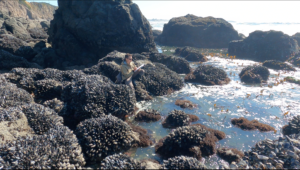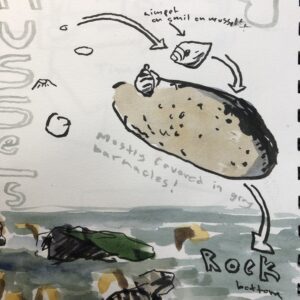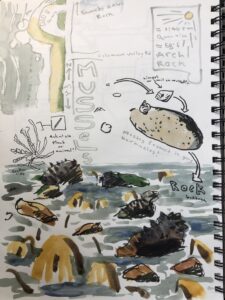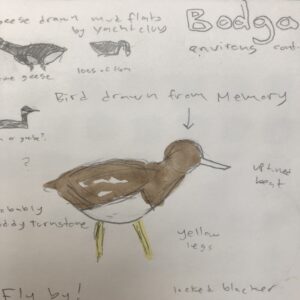What do you like to do during the low tide? If you’re like Marley Peifer, you might enjoy going to the rocky shore, doing some nature journaling of the intertidal zone, and maybe even harvesting dinner! Join Marley as he explores the intertidal zone.
Tidepools are a dynamic place to visit, changing rapidly with the ocean and weather. Marley is quick to note the high “information density”:
“The main intellectual challenge in nature journaling at the tidepools is: there is so much information density, so many things to look at, so many potential subjects to choose from, that your main challenge is going to be focusing!”

Safety is #1.
Focusing on any one topic at the intertidal zone is one challenge; the other (arguably more important) one concerns logistics. It is vital to remain aware of your surroundings at all times when you’re this close to the ocean. The rocks are slippery and easy to fall on; the uneven terrain can catch your foot and get you stuck; and the ocean itself can catch you with its powerful waves. “Never turn your back on the ocean,” Marley is explaining – right as the ocean splashes him on the butt. He notes that it is better to come with a friend when exploring the rocky shore or intertidal zone.

So where do you start?
Despite the information density, Marley has a plan! He follows a setup that helps him get information down quickly without getting overwhelmed:
- First, he situates himself so that he can observe safely and as comfortably as possible, and he secures his nature journal with binder clips so the pages won’t fly around while he’s journaling.
- Second, he takes down the metadata: when and where he is, and what the weather is like.
- Third, he makes a landscape rendering of the place, which really helps to set the scene.
- Fourth, he zooms in on a subject. In this case, it’s one that isn’t moving, which allows for a longer time to observe the subject directly.
- Fifth, he keeps his awareness of his surroundings and of any exciting fast-moving natural developments he might want to observe.

Later, he uses his close focus binoculars to try to observe a turnstone – mostly because the bird is far away and he wants to observe it before it flies off, but also because it is safer to observe from a distance, out of the ocean’s reach. Unfortunately the bird flies away very quickly, but Marley uses the information he has to make a memory drawing. By recording as many details as he can recall, Marley is cementing those details in his mind. He is also making it easier for himself to try to research the bird when he gets home.

How to nature journal a landscapito of the intertidal zone:
Marley has some tips for capturing a landscapito of this special location. For more landscapito tips, check out Marley’s earlier post here.
- Punch in your dark values first, being mindful to reserve your whites. To capture the dark shapes in his landscapito, Marley uses a Pilot Futayaku Brush pen.
- Put more details in the foreground; this is where the eye is drawn.
- Put in only the suggestion of water at first.
- When you begin using the watercolors, put in your lightest values first. In this case, that would be both the sky and the ocean, which Marley puts in at the same time. He uses John Muir Laws’s watercolor palette, which you can find here, and a Pentel large waterbrush.
- Add the darker values in the foreground.
- Now give this first layer of watercolor time to dry; the humidity near the ocean will make your page dry slower than you might be used to.
- Adjust any values and saturations after the first layer has dried.
- If needed, add back in your whites.

When it comes to adding white back into the landscapito, don’t be hard on yourself. Reserving whites is challenging and takes practice! You can add the whites back in using an opaque media, like the Presto Jumbo Correction Pen Marley uses. Always test the opaque media off to the side first before using it on your main piece, and be sure to stop before you actually feel ready. Otherwise playing with the correction pen might get too fun, and you might overdo it.
Marley’s practice and pencil miles pay off: he is able to get pages of rich information about his intertidal adventure AND harvest dinner! ¡Buen provecho!

If you are just getting started with nature journaling check out this post : How to Nature Journal in 10 Steps
Need help choosing nature journaling supplies? Check out Nature Journaling Supplies: What You Need and What You Do Not